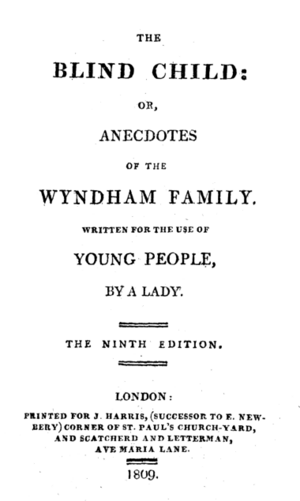Elizabeth Pinchard facts for kids
Elizabeth Pinchard was an English writer who lived from about 1791 to 1820. She wrote exciting stories for children, especially for older girls. Her books always taught important lessons about how to be a good person. Her most famous and successful book was called The Blind Child.
Contents
Writing Stories That Teach Lessons
Elizabeth Pinchard's children's books were "didactic." This means they were designed to teach moral lessons. She really looked up to other writers like Anna Laetitia Barbauld and Genlis. These writers believed that teaching children was more important than just telling a fantasy story. Elizabeth Pinchard wanted her books to do the same thing.
In her first book, The Blind Child, or Anecdotes of the Wyndham Family (published in 1791), she wrote about her hopes. She wanted to "awaken in the rising generation" a "lively wish for goodness." In this special book, she taught that being too soft-hearted isn't always true kindness. After the main character, who is blind, gets her sight back, the doctor praises her sister. He says the sister didn't show "exaggerated feeling." Her mother adds that true kindness is better than "false tenderness."
Popularity of The Blind Child
The Blind Child was a huge hit! It was printed many times over the next 20 years. People bought it in England and also in North America. When it first came out, the book said it was "by a lady." But later, her other books often said they were "by the author of The Blind Child." This shows how well-known that first book became. It is still her most famous work today.
In her stories, Elizabeth Pinchard often wrote conversations like simple plays. The characters would speak directly to each other. Her next book, Dramatic Dialogues (1792), even looked like a collection of short plays. Back then, some people didn't like the idea of girls acting in plays. But Pinchard explained why she used dialogue. She thought it was easier to keep young readers interested. It was better than always writing "she said" or "he replied."
More Moral Stories
Elizabeth Pinchard always cared about teaching good morals to young people. This was clear from the title page of her book The Two Cousins (1794). It was called "a moral story for the use of young persons." The book showed "the necessity of moderation and justice to the attainment of happiness." This means it taught that being fair and not going to extremes helps you find happiness.
She wrote other stories too, like Ward of Delamere and Family Affection: a tale for youth. She also wrote Mystery and Confidence and The Young Countess, which came out in 1820. Around that time, a review praised all her books. It said that another famous children's writer, Sarah Trimmer, liked them too. The review said Pinchard's books were valuable because she always tried to teach children. She wanted them to have "habits of piety" (being religious and good). This was seen as the best way to have a good reputation.
Books Available Online
- The Blind Child
- Dramatic Dialogues
- The Two Cousins
- Family Affection
- Mystery and Confidence
Images for kids



